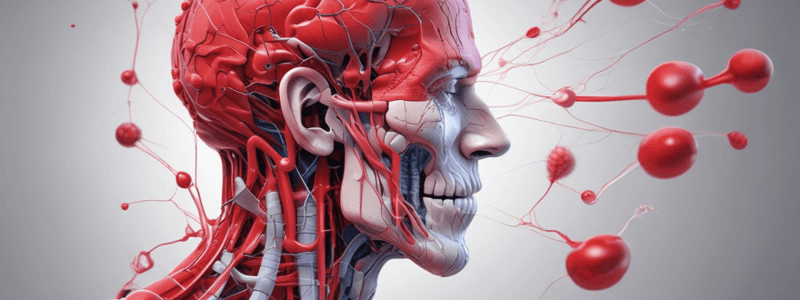Podcast
Questions and Answers
Pulmonary ventilation is the process of moving air into and out of the lungs.
Pulmonary ventilation is the process of moving air into and out of the lungs.
True (A)
Arteries carry deoxygenated blood away from the heart, while veins carry oxygenated blood back to the heart.
Arteries carry deoxygenated blood away from the heart, while veins carry oxygenated blood back to the heart.
False (B)
The central nervous system contains the brain, spinal cord, and all the nerves in the body.
The central nervous system contains the brain, spinal cord, and all the nerves in the body.
False (B)
The bones in the pelvic area are the ilium, ischium, and pubis.
The bones in the pelvic area are the ilium, ischium, and pubis.
Capillaries are thick blood vessels where the exchange of gases, nutrients, and wastes occurs.
Capillaries are thick blood vessels where the exchange of gases, nutrients, and wastes occurs.
The normal respiratory rate for an adult is 30-60 breaths per minute.
The normal respiratory rate for an adult is 30-60 breaths per minute.
The pancreas is part of the endocrine system and produces insulin to regulate blood sugar.
The pancreas is part of the endocrine system and produces insulin to regulate blood sugar.
The left ventricle is responsible for pumping deoxygenated blood to the lungs, while the right ventricle pumps oxygenated blood to the body.
The left ventricle is responsible for pumping deoxygenated blood to the lungs, while the right ventricle pumps oxygenated blood to the body.
Emphysema is a respiratory disease caused by smoking that results in the breakdown of alveoli, which impairs gas exchange.
Emphysema is a respiratory disease caused by smoking that results in the breakdown of alveoli, which impairs gas exchange.
Redirection is a technique used to bring a patient's focus back to the immediate situation or crisis.
Redirection is a technique used to bring a patient's focus back to the immediate situation or crisis.
Platelets are the blood cells responsible for carrying oxygen.
Platelets are the blood cells responsible for carrying oxygen.
DOT manages the training standards of Emergency Medical Responders (EMRs) and Paramedics.
DOT manages the training standards of Emergency Medical Responders (EMRs) and Paramedics.
Aspiration occurs when food or liquid accidentally enters the lungs.
Aspiration occurs when food or liquid accidentally enters the lungs.
During exhalation, the intercostal muscles in the chest wall contract.
During exhalation, the intercostal muscles in the chest wall contract.
Supine position is when a person is lying on their stomach.
Supine position is when a person is lying on their stomach.
White blood cells are responsible for carrying oxygen in the blood.
White blood cells are responsible for carrying oxygen in the blood.
Coronary arteries are the arteries that carry blood away from the heart.
Coronary arteries are the arteries that carry blood away from the heart.
Ventricles are the superior chambers of the heart.
Ventricles are the superior chambers of the heart.
Capillaries are small arteries connected to capillaries.
Capillaries are small arteries connected to capillaries.
Rigor mortis is characterized by poor blood flow or poor perfusion.
Rigor mortis is characterized by poor blood flow or poor perfusion.
CPR is contraindicated in individuals with a DNR (Do not resuscitate) order.
CPR is contraindicated in individuals with a DNR (Do not resuscitate) order.
Infants fall under the age classification of Early Adulthood.
Infants fall under the age classification of Early Adulthood.
What are the contraindications for using a Nasopharyngeal Airway (NPA)?
What are the contraindications for using a Nasopharyngeal Airway (NPA)?
When should the Jaw Thrust maneuver be used in emergency care?
When should the Jaw Thrust maneuver be used in emergency care?
What are the age classifications for CPR, from toddler to late adulthood?
What are the age classifications for CPR, from toddler to late adulthood?
What are the signs of poor perfusion or poor blood flow in a patient?
What are the signs of poor perfusion or poor blood flow in a patient?
What is the purpose of a c spine collar in emergency medical care?
What is the purpose of a c spine collar in emergency medical care?
When is CPR contraindicated?
When is CPR contraindicated?
What is the role of platelets in the blood?
What is the role of platelets in the blood?
Define the term 'Standard Precautions' in the context of healthcare.
Define the term 'Standard Precautions' in the context of healthcare.
Explain what happens during the process of inhalation.
Explain what happens during the process of inhalation.
What is the significance of the Department of Transportation (DOT) in relation to emergency medical services?
What is the significance of the Department of Transportation (DOT) in relation to emergency medical services?
Describe what happens during the process of exhalation.
Describe what happens during the process of exhalation.
What is the definition of aspiration in a medical context?
What is the definition of aspiration in a medical context?
What is the function of the left ventricle?
What is the function of the left ventricle?
What is the difference between arteries and veins?
What is the difference between arteries and veins?
What is cyanosis, and what causes it?
What is cyanosis, and what causes it?
Describe the function of capillaries in the human body.
Describe the function of capillaries in the human body.
What is the role of the pancreas in the human body?
What is the role of the pancreas in the human body?
Define the term 'hypoxia' and its potential consequences.
Define the term 'hypoxia' and its potential consequences.
What is the difference between systolic and diastolic blood pressure?
What is the difference between systolic and diastolic blood pressure?
Describe the function of the central nervous system (CNS).
Describe the function of the central nervous system (CNS).
What is the role of white blood cells in the human body?
What is the role of white blood cells in the human body?
Define the term 'redirection' in the context of emergency medical care.
Define the term 'redirection' in the context of emergency medical care.
Flashcards are hidden until you start studying




